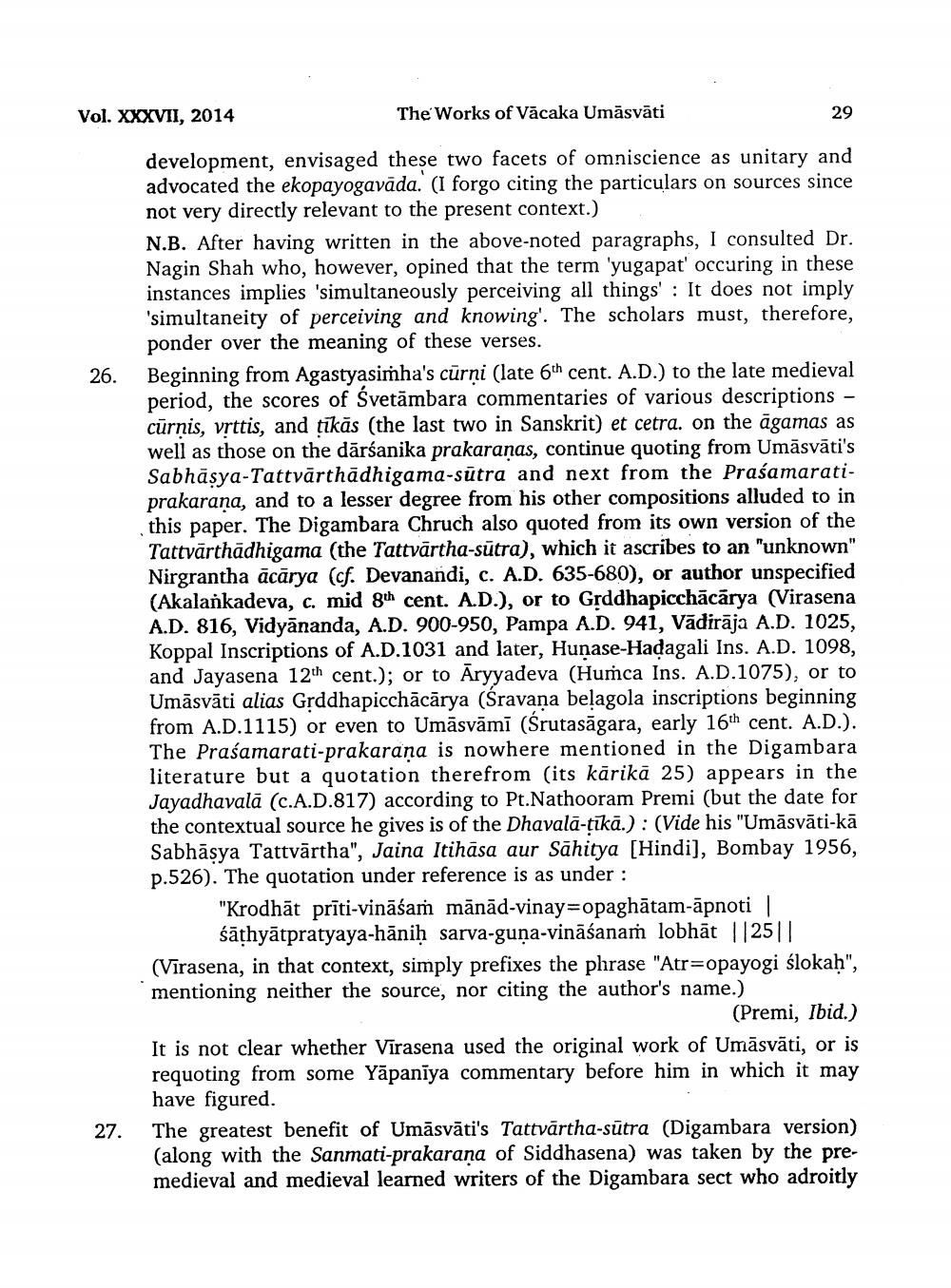________________
Vol. XXXVII, 2014
The Works of Vācaka Umāsvāti
29
26.
development, envisaged these two facets of omniscience as unitary and advocated the ekopayogavāda. (I forgo citing the particulars on sources since not very directly relevant to the present context.) N.B. After having written in the above-noted paragraphs, I consulted Dr. Nagin Shah who, however, opined that the term 'yugapat' occuring in these instances implies 'simultaneously perceiving all things' : It does not imply 'simultaneity of perceiving and knowing'. The scholars must, therefore, ponder over the meaning of these verses. Beginning from Agastyasimha's cūrņi (late 6th cent. A.D.) to the late medieval period, the scores of Svetāmbara commentaries of various descriptions - cūrnis, vrttis, and tīkās (the last two in Sanskrit) et cetra. on the agamas as well as those on the dārśanika prakaranas, continue quoting from Umāsvāti's Sabhāsya-Tattvārthādhigama-sūtra and next from the Prasamaratiprakarana, and to a lesser degree from his other compositions alluded to in this paper. The Digambara Chruch also quoted from its own version of the Tattvārthādhigama (the Tattvartha-sūtra), which it ascribes to an "unknown" Nirgrantha ācārya (cf. Devanandi, c. A.D. 635-680), or author unspecified (Akalankadeva, c. mid 8th cent. A.D.), or to Grddhapicchācārya (Virasena A.D. 816, Vidyānanda, A.D. 900-950, Pampa A.D. 941, Vădirāja A.D. 1025, Koppal Inscriptions of A.D.1031 and later, Hunase-Hadagali Ins. A.D. 1098, and Jayasena 12th cent.); or to Aryyadeva (Humca Ins. A.D.1075), or to Umāsvāti alias Grddhapicchācārya (Sravana belagola inscriptions beginning from A.D.1115) or even to Umāsvāmī (Srutasāgara, early 16th cent. A.D.). The Praśamarati-prakarana is nowhere mentioned in the Digambara literature but a quotation therefrom its kārikā 25) appears in the Jayadhavalā (c.A.D.817) according to Pt.Nathooram Premi (but the date for the contextual source he gives is of the Dhavalā-tikā.): (Vide his "Umāsvāti-kā Sabhāsya Tattvārtha", Jaina Itihasa aur Sāhitya [Hindi], Bombay 1956, p.526). The quotation under reference is as under:
"Krodhāt prīti-vināśam mānād-vinay=opaghātam-āpnoti
śāthyātpratyaya-hāniḥ sarva-guna-vināśanam lobhāt 1|25|| (Virasena, in that context, simply prefixes the phrase "Atr=opayogi ślokah", mentioning neither the source, nor citing the author's name.)
(Premi, Ibid.) It is not clear whether Virasena used the original work of Umāsvāti, or is requoting from some Yāpaniya commentary before him in which it may have figured. The greatest benefit of Umāsvāti's Tattvārtha-sūtra (Digambara version) (along with the Sanmati-prakarana of Siddhasena) was taken by the premedieval and medieval learned writers of the Digambara sect who adroitly
27.




